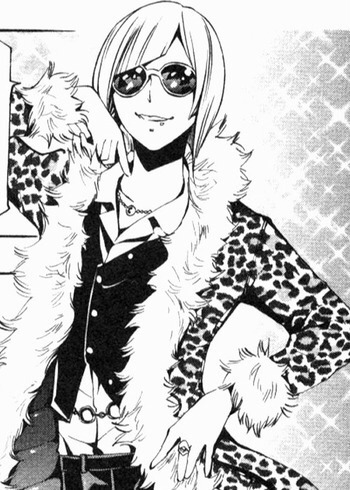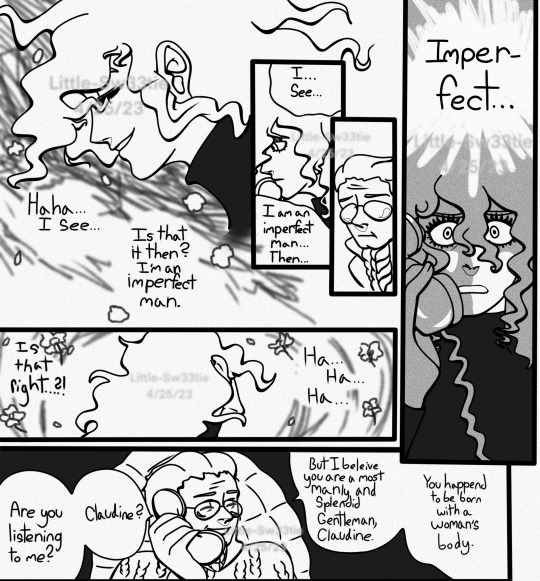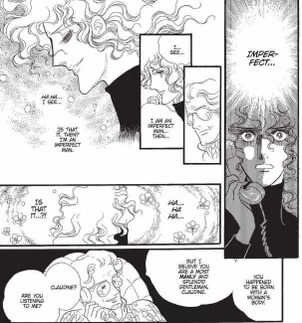#claude de montesse
Explore tagged Tumblr posts
Text

Transmasc blonde bishounen
60 notes
·
View notes
Text
"Who's Hotter? Pride Month Event: Canon Trans Characters






The requester provided additional info about the characters trans identity, which is below the cut
Kikunojo: Says she's a "woman at heart", which is a Japanese expression basically meaning she's a trans woman.
Kenji Hikiishi: Confirmed to be a trans woman.
Masaru "Chaplin" Sukegawa: A trans woman who started identifying and presenting femininely sometime before the start of the series. Is shown dealing with discrimination as a transgender inmate.
Aoi Futaba: A trans woman who started identifying and presenting femininely sometime before the start of the series. Repeatedly struggles to find a boyfriend who will accept her.
Nao: A trans woman who started identifying and presenting femininely sometime before the start of the series. Reveals this to the protagonist early in the story.
Claude de Montesse: The whole manga is about his life and struggles living as a trans man in early 20th century France.
#kikunojo#one piece#kenji hikiishi#my hero academia#boku no hero academia#masaru sukegawa#deadman wonderland#aoi futaba#You're Under Arrest!#nao#ice revolution#claude de montesse#claudine manga#pride month#transgender#lgbtq#anime#polls#anime poll#whoishotteranimepolls
60 notes
·
View notes
Text

I could never love any man but you anyways
112 notes
·
View notes
Text

AWAAAAAAAAAAA
#alphys#Grillby#undertale fanart#horrortale sans#utmv fanart#sun dca#moon dca#dca fandom#Brett Hand#Inside Job Fanart#Eridan Ampora#homestuck fanart#Wally Darling#welcome home fanart#Claude de Montesse#Claudine fanart#Covering my bases giving me a million tags LMAOOOO#Leon/Toni’s Art
63 notes
·
View notes
Text

In honor of me somehow finding this manga at a local bookstore, to my extreme surprise.
I thought this artstyle would be somewhat easier to attempt than several others I’ve encountered already, mainly the hair, which…turned out to be the hardest part. Yet again, I was extremely wrong, but I hope my rendition is close enough.
#art#my art#rkgk#claude de montesse#claudine manga#asachuu#on that note#confession for my mutuals#the first thing I did when I saw this manga again after a year or two of not having read it#was flip to a page where there is one single speech bubble mentioning Rimbaud#because that’s all I really remembered#aside from a very vague rundown
22 notes
·
View notes
Text
Rip Claude you would’ve loved hrt
We lost a real one fr 😔
#claude de montesse#claudine manga#claudine...!#riyoko ikeda#claudine spoilers#claudine…! spoilers#putting that there just in case#my posts
6 notes
·
View notes
Text

trans character of the day: claude de montesse from claudine…!
(he/him)
2 notes
·
View notes
Text

transmasc character of the day: claude de montesse from claudine…!
2 notes
·
View notes
Text
Just read the very short manga from the 70’s called Claudine, about a trans man, Claude de montesse in the early 20th century, very good, very sad, surprisingly good representation despite it being a tragedy, but sadly the version I read refers to him solely with she/her pronouns despite being very clear and explicit with the fact he is a man.
Definitely recommend giving it a read
6 notes
·
View notes
Text
⚠️Vote for whomever YOU DO NOT KNOW⚠️‼️


#ultimate obscure blorbo#polls#Round I#Clarice (Castle Of Nations)#Castle Nations#Claudine “Claude” De Montesse#Claudine...!
10 notes
·
View notes
Text
Today’s LGBT+ Character is;

Claude de Montesse from Claudine by Riyoko Ikeda-Transgender Man
Species: Human
Requested by Anon
Status: Deceased
#Claude de Montesse#Claudine#transgender#deceased#manga#lgbt#character of the day#requested#fandoms I'm not in#riyoko ikeda#LGBTQueue
56 notes
·
View notes
Photo

The canon LGBT+ character of the day is
Claude de Montesse from Claudine…!, who is a trans man!
130 notes
·
View notes
Photo

Claude deserved so much better 😢
6 notes
·
View notes
Text

Claude and Rosemarie
102 notes
·
View notes
Text

Redrew a page from Ikeda Riyoko’s manfa Claudine!!! I love this manga so much, Claude is the beloved ever<3
Original page under the cut!

#Claudine (1978 Ikeda)#Claude De Montesse#Claudine (1978)#Riyoko Ikeda#Ikeda Riyoko#Claude De Montesse Fanart#Leon/Toni’s Art
32 notes
·
View notes
Photo

((( L'ESPRIT FRANÇAIS CONTRE-CULTURES, 1969-1989 ,,,
"L'esprit français, Contre-cultures 1969-1989"
De la Figuration Narrative à la violence graphique de Bazooka, des éditions Champ Libre à la création des radios libres, de Hara-Kiri à Bérurier Noir, cette exposition rend compte d’un « esprit français » critique, irrévérencieux et contestataire, en proposant une multitude de filiations et d’affinités. À travers une soixantaine d’artistes et plus de 700 oeuvres et documents, rassemblant à la fois journaux, tracts, affiches, extraits de films, de vidéos et d’émissions de télévision, l’exposition assume une forme de révision esthétique, en allant regarder vers d’autres “genres” de la création que ceux généralement mis en avant dans l’art contemporain. Elle est également l’occasion de présenter des pièces rarement montrées telles que des carnets du groupe Dziga Vertov (fondé par Jean-Luc Godard et Jean-Pierre Gorin), une sculpture monumentale de Raymonde Arcier ou les « livres d’école » d’Henri et Marinette Cueco ainsi que de passer commande d’œuvres inédites à Kiki Picasso (Il n’y a pas de raison de laisser le blanc, le bleu et le rouge à ces cons de français, 2016-2017), Jean-Jacques Lebel (L’Internationale Hallucinex, 1970-2017) et Claude Lévêque (Conte cruel de la jeunesse, 1987-2017).
Sexualités, militance, dandysme et violence opèrent comme des fils rouges dans l’exposition qui s’organise en chapitres notamment consacrés aux contre-éducations, au sabotage de l’identité nationale, mais aussi à l’influence du Marquis de Sade sur certaines pratiques radicales. Les modes de production et de diffusion alternatives dans la presse et les médias, en même temps que la persistance d’une violence contestataire et sa répression tout aussi brutale, construisent aussi un paysage social qui s’assombrit, sur fond de crise, d’émergence du chômage de masse, de ségrégation et d’une banlieue trop froide ou trop chaude qui catalyse les malaises.
En France, de la contre-culture à la sous-culture, il n’y a qu’un pas. Beaucoup parmi les artistes montrés, ont d’ailleurs fait le choix volontaire et manifeste de ne pas aller vers l’art, tout en restant à côté, parfois tout proche, comme pour y puiser sans en subir les prescriptions. D’autres, à l’intérieur même de ce champ, sont restés fidèles, à des manières qui ne se faisaient pas : figuration, caricature, ethnographie, militance politique. Autant de dissidences esthétiques qui sont des formes de résistance à un ordre formel des choses et qui viennent redonner de la diversité à une histoire de l’art français un peu monochrome. À travers la convocation d’idées et de pratiques singulières, qui furent un temps marginalisées, il s’agit, sans nostalgie, d’éclairer des mutations culturelles mais aussi de réactiver certaines énergies au présent.
Artistes et auteur.e.s de l'exposition
Djouhra Abouda et Alain Bonnamy, Olivier Agid, Émile Aillaud, Gilles Aillaud, Malek Alloula, Raymonde Arcier, Adolfo Arrietta, Jean Aubert, Jean-Christophe Averty, Igor Barrère, Cathy Bernheim, Bérurier Noir et Laul, Alain Bizos, Julien Blaine, Bertrand Blier, Jean-Pierre Bouyxou et Raphaël Marongiu, Régis Cany, Claude Caroly, Henri Cartier-Bresson, Jules Celma, Olivia Télé Clavel, Nicole Claveloux, Collectif Eugène Varlin et Jacques Kebadian, le Collectif Mohammed, Coluche, la Coopérative des Malassis (Bernard Alleaume, Henri Cueco, Jean-Claude Latil, Mikaëloff, Martin Parré, Gérard Tisserand), Copi, Jean-Louis Costes, Alfred Courmes, Jean Criton, Marinette Cueco, Jorge Damonte, Pierre Desproges, Elles Sont De Sortie (Pascal Doury et Bruno Richard), Catherine Faux, Dan & Guy Ferdinande, Lucien Fleury, Marie France, Bernard Froidefond (Lastar Crémière), Dominique Fury, Serge Gainsbourg, Jean-Pierre Gallèpe, Jean-François Gallotte et Joëlle Malberg, Gébé, Michel Giniès, le Groupe Dziga Vertov (Jean-Luc Godard et Jean-Pierre Gorin), Daniele Huillet et Jean-Marie Straub, Les Insoumuses (Nadja Ringart, Carole Roussopoulos, Delphine Seyrig et Ioana Wieder), Françoise Janicot et Bernard Heidsieck, Michel Journiac, Jean-Paul Jungmann, Peter Klasen, Pierre Klossowski, Eustachy Kossakowski, Arnaud Labelle-Rojoux, Claude Lalanne, Lulu Larsen, Alain Le Saux, Jean-Jacques Lebel, Jean-Patrick Lebel, Claude Lévêque, Lea Lublin, Annette Messager, Pierre Molinier, Jacques Monory, Chantal Montellier, Alain Montesse, Philippe Morillon, Didier Moulinier, Edgard Naccache, ORLAN, Frédéric Pardo, Michel Parmentier, Kiki Picasso, Loulou Picasso, Pierre et Gilles, Daniel Pommereulle, Professeur Choron, Jean-Marc Reiser, Michel Saloff-Coste, Siné, Romain Slocombe, Lionel Soukaz, Lucien Suel, T5Dur, Thierry Tillier, Roland Topor, Jean-Marc Toulassi, Clovis Trouille, le Groupe Utopie, Paul Vecchiali, Bernard Vidal, Georges Wolinski, Henri Xhonneux, Jean Yanne, Rocking Yaset, Pierre Zucca.
19 notes
·
View notes